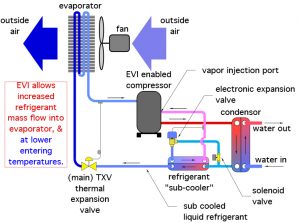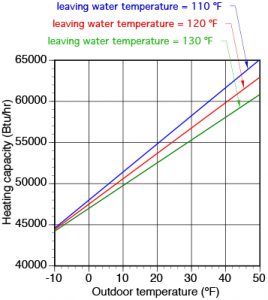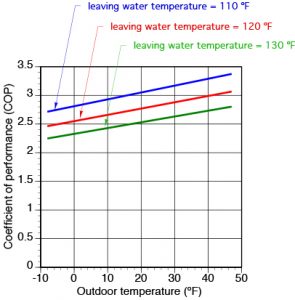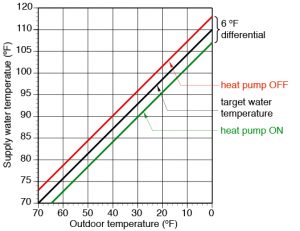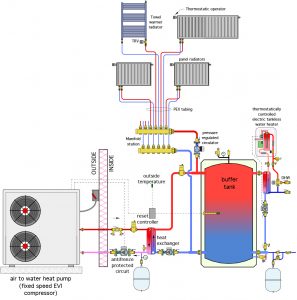
Low ambient air-to-water heat pumps
May 12, 2016 | By JOHN SIEGENTHALER
Electrically powered heat pumps, in many varieties, are destined to play an increasingly important role in heating and cooling buildings around the world. They convert vast amounts of otherwise unusable low temperature heat into heat at sufficient temperatures to warm buildings or heat domestic water.
Electrically powered heat pumps dovetail nicely with large-scale renewable sources of electrical energy such as utility scale photovoltaic systems, large wind turbine farms, or CHP systems operating on bio-gases produced from agricultural waste.
NOT WHAT THEY USED TO BE
The “classic” heat pump for residential heating and cooling debuted in North America during the 1970s. Big name HVAC companies developed markets for these early generation “air-to-air” heat pumps, which consisted of two major subassemblies: an outdoor condenser unit, and an indoor air handler. A refrigeration line set connected these subassemblies.
Although air-to-air heat pumps have been around for several decades, early generation products were not able to maintain reasonably efficient operation at low outdoor air temperatures. It was not uncommon to turn off those early generation heat pumps when outdoor temperatures dropped to or below 20F. However, advances in refrigeration technology, including inverter drive variable speed compressors, and a process known as enhanced vapour injection (EVI) now allow air-source heat pumps to operate at very low outdoor temperatures, typically down to -13F (-25C).
Some of the largest global providers of heating and cooling hardware, now offer “cold climate” versions of air-to-air heat pumps. The most common configuration is called a ductless mini-split heat pump system. A single outdoor unit connects to multiple indoor wall mounted cassettes, each supplied by its own refrigeration line set. Each indoor unit can operate independently, allowing for zoning.
Although cold climate ductless mini-split heat pumps have carved out a nice market share over the last decade, they rely on forced air delivery of heating and cooling. As such they do not offer the potential to combine their high thermal efficiencies with the comfort provided by a well-designed hydronic distribution system. Furthermore, most ductless mini-split heat pump systems only provide space heating and cooling and lack the ability to supply ancillary loads such as domestic water heating, or pool/spa heating.
WATER RATHER THAN AIR
This is where a different heat pump configuration becomes attractive. An air-to-water heat pump uses the same concept as an air-to-air heat pump for extracting low temperature heat from outdoor air. The difference is that it delivers heat at very useful temperatures into a stream of water (rather than air) passing through its condenser.
Some air-to-water heat pumps are capable of producing leaving water temperatures of 130F+, even with relatively cold outdoor air. This sets the table for use of hydronic heat emitters such as radiant floors, radiant walls and radiant ceiling panels, panel radiators, fan-coil convectors, and even contemporary low temperature fin-tube baseboard. It also allows the heat pump system to be configured to provide most, if not all of the energy needed for domestic water heating. With a suitable heat exchanger, heated water from an air-to-water heat pump can also be used to heat a swimming pool or maintain the water temperature in a spa.
A WHAT?
Although most North American heating professionals are familiar with ductless mini-split heat pumps, as well as geothermal heat pumps, few of them are familiar with air-to-water heat pumps.
This is not the case in other markets such as Asia and Europe. According to the August 2015 issue of the Japanese publication JARN, the 2014 global market for air-to-water heat pumps totaled over 1.7 million units. The Chinese market alone represented almost one million units sold in 2014. The European market was 232000 units, with France as the number one market, followed by Germany and the U.K. The same Asian-based firms that sell ductless mini-split heat pumps in North America produced many of these air-to-water heat pumps. Others came from European-based companies. The U.S. market was a tiny fraction of global sales.
Why such a difference? One likely reason is the small market for residential hydronics in the U.S. and Canada relative to Asian and European markets. Another is the very limited use of chilled water cooling in smaller North American buildings. Manufacturers also have to consider the cost of supporting a new product line in a market (such as North America) that requires a lot of “hand holding” before the installations become routine.
LOOKING AHEAD
This is not to suggest that a strong future market for air-to-water heat pumps cannot develop in North America. Several trends suggest just the opposite. Here are some key indicators:
1 | Growing interest in net zero energy (NZE) houses: The typical NZE house has a very low loss thermal envelop and a sizable solar photovoltaic array on the roof. Net metering laws – where they exist – allow owners of photovoltaic systems to sell surplus electrical power back to the utility at full retail rate. Thus, surplus kilowatt hours produced on a sunny summer day could conceivably be “parked” on the electrical grid and reclaimed to run a heat pump on a cold winter night with no technical or economic penalty. That is a pretty sweet deal.
One common approach to heating and cooling NZE homes is to install two or three high wall cassettes, that is the indoor portion of a ductless mini-split heat pump system, in central areas and leave interior doors open for distribution of the heated or cooled air. Proponents of this approach stress that no interior comfort distribution system, such as ducting or piping, is needed. One online discussion of this topic states that if all interior doors are left open, interior air temperatures will stabilize at not less than 2F below the air temperature where the indoor cassette is located. This discussion also points out that if bedroom doors are closed at night, which is a reasonable expectation, the bedroom temperature may drop 5F below the temperature where the heat pump indoor unit is located.
Should these constraints be accepted without reservation?
I say not because there is a difference between just putting Btus back into a space to match the rate of heat loss and doing so in a way that provides excellent thermal comfort. There are also reasons builders put doors on interior rooms and it is not for achieving 5F automatic temperature setbacks when they are closed. In my opinion, these constraints represent significant “negatives” for the ductless mini-split approach in a NZE house.
The alternative is to retain the thermal efficiency of the low ambient air-source heat pump, but switch to hydronics for the balance of the system.
Use a low temperature hydronic delivery system, such as a heated ceiling or floor, to allow good thermal performance from the heat pump along with proper distribution of heat throughout the building, whether the doors are open or closed.
Cooling can be handled using chilled water flowing through a central air handler, or multiple small air handlers, some of which look and operate almost identically to the high wall cassettes used with ductless mini split heat pumps.
All chilled water air handlers must be equipped with condensate drip pans and suitable drains. Cooling can also be done using a radiant panel in combination with a single small air handler. The radiant panel can handle most, if not all of the sensible cooling load. It must operate at chilled water temperatures that remain above the room’s dewpoint at all times. This can be handled with mixing controls. A single small air handler would also be required to provide moisture removal.
2 | In the U.S., the 30 per cent federal tax credits on geothermal heat pump systems are scheduled to end as of December 31, 2016: This will remove a significant purchasing incentive, and force geothermal heat pump systems to compete against other types of heat pumps in an unsubsidized market.
3 | Air-to-water heat pumps are significantly less expensive to install compared to geothermal heat pumps: This is especially true if vertical boreholes are required for the earth loop. In my area, these holes cost about $3000 per ton for drilling, pipe insertion, and grouting. Additional cost is incurred for connecting multiple vertical piping loops and for routing piping back to the location of the heat pump. Replacement of any affected pavements or landscaping also needs to be factored into the cost of installing a geothermal heat pump system.
4 | Diminishing returns are a factor: As home heating loads become smaller due to better thermal envelopes, the difference in annual heating costs, between heat pumps operating at seasonal average coefficient of performance (COP) that vary by perhaps 1.0 or less, decreases. The incrementally lower operating cost of the higher performance heat pump may not be able to amortize the higher installation cost within the expected life of the system.
For example: A home with a design heat loss of 25000 Btuh based on an outdoor temperature of 0F and indoor temperature of 70F, and located in a 7000F•day climate, would have an estimated annual heating requirements of about 39 MMBtu/year. If this load were supplied using a geothermal heat pump with a seasonal average COP of 3.3 (which includes the power required to operate the earth loop circulators), in a location where electrical energy is priced at $0.12 per kWh, the annual heating cost would be about $416. If the same 39 MMBtu/year were supplied from a low ambient air-to-water heat pump with a seasonal average COP of 2.7, the annual heating cost would be about $508. The difference, $92 per year, would not be able to amortize what could easily be a (after tax credit) $7000 to $9000 higher installation cost within the life of the equipment.
5 | As home space heating loads get smaller, the domestic water heating load becomes an increasingly higher percentage of the total annual heating energy requirement: Some estimates put the DHW load at 25-30 per cent of the total annual energy requirement in a well insulated modern home.
Most ductless mini-split heat pumps cannot provide domestic water heating, but a properly configured air-to-water heat pump can.
A standard electric water heater providing domestic water heating in a situation where the heat pump cannot, delivers heat at a COP of 1.0. If that energy was instead attained through an air-to-water heat pump, it could be delivered at a COP averaging perhaps 2.5 over the year. For a family of four needing 60 gallons per day of water heated from 50F to 120F and assuming electrical energy priced at $0.12 per kwHr, the difference in annual domestic water heating cost between these scenarios is $270. That is roughly three times more than the annual savings associated with using a geothermal heat pump versus the air-to-water heat pump in the previous example.
SUB-ZERO
A modified vapour-compression refrigeration system has been developed to further improve the heating capacity and coefficient of performance (COP) of air-to-water heat pumps operating in low outdoor air temperature conditions. This technique, known as enhanced vapour injection, (EVI), uses another heat exchanger placed between the outlet of the condenser, and the inlet of the thermal expansion valve, as shown in Figure 1.
This additional heat exchanger is called a “sub-cooler.” It reduces the temperature of liquid refrigerant leaving the condenser, allowing for even lower temperatures when that refrigerant passes through the main thermal expansion valve and on into the evaporator. It does this by directing a portion of the liquid refrigerant through an electronically controlled thermal expansion valve, which causes the refrigerant to vaporize and extract more heat from the remainder of the liquid refrigerant flowing through the other side of the sub-cooler.
The vaporized refrigerant leaving the upper side of the sub-cooler flows back to a special port on the compressor and is injected at an intermediate port between the scrolls. The net effects of EVI are increased compression ratio in the compressor, and cooler refrigerant entering the evaporator. Both of these effects reduce the drop in heating capacity and COP at low ambient temperatures. Figures 2 and 3 show the heating capacity and COP ratings for one EVI-enabled air-to-water heat pump currently available in North America.
Notice that both heating capacity and COP are highly dependent on outdoor air temperature. This is always the case with air source heat pumps. Still, the EVI-equipped air-to-water heat pump represented by these graphs maintains a COP of 2.55 when producing 120F leaving water temperature, and operating at an outdoor air temperature of 0F. At an outdoor temperate of 25F, and the same 120F leaving water temperature, the COP is about 2.8. This compares to a COP of about 2.3 for an air-to-water heat pump with an inverter drive compressor operating under the same conditions. That is a relative performance gain of about 22 per cent, which implies 22 per cent higher heat output for the same electrical input. Furthermore, based on manufacturer’s data, the inverter drive heat pump cannot maintain the 120F leaving water temperature at outdoor air temperatures below approximately 22F. At 5F outdoor temperature, the latter heat pump can only maintain a leaving water temperature of 104F.
THE LOWER THE BETTER
The graphs in Figures 2 and 3 imply the advantage of combining the air-to-water heat pump with a low temperature heating distribution system. This is especially true for COP. For example, at 20F outdoor temperature, a distribution system that can deliver the heating load of the building using 110F water would allow the heat pump to reach a COP of about 3.1, whereas a system requiring 130F water would only allow a COP of about 2.5.
The best way to operate the heat pump at the lowest possible water temperature is to incorporate outdoor reset control as the “logic” for maintaining the temperature within a buffer tank.
An outdoor reset controller continuously calculates the “target” water temperature that can just meet the heating load, based on the current outdoor temperature. It operates the heat pump to maintain the buffer tank within a narrow range of temperature centered on this target temperature.
For example, if the buffer tank supplied a radiant floor heating system with a target supply water temperature of 110F at 0F outdoor conditions, the heat pump would attempt to maintain the mid-height point on the buffer tank between a low of perhaps 107F, and a high of 113F. However, if the outdoor temperature was 35F, the target supply water temperature would drop to about 90F. Under these conditions the outdoor reset controller would operate the heat pump to maintain the buffer tank between 87 and 93F. These conditions, along with the overall operating range of the outdoor reset control are shown in Figure 4.
PUTTING IT TOGETHER
Figure 5 shows a system designed to supply space heating and most of the domestic hot water load using a low ambient air-to-water heat pump.
The heat pump is connected to a relatively short piping circuit filled with an antifreeze solution. In heating mode, the heated antifreeze solution passes through the brazed plate heat exchanger, which has been sized so that the water temperature leaving the heat exchanger is not more than 5F lower than the temperature of the antifreeze solution coming from the heat pump. Because the heat pump circuit is an isolated closed loop, it must be equipped with a pressure relief valve, expansion tank, air separator, fill/purging valves and a suitably sized circulator.
The heated water flows to the short header at the upper left side of the buffer tank. If one or more of the heat emitters is active, some of this water passes to the homerun distribution system. The rest flows into the buffer tank.
The outdoor reset controller monitors the temperature of the sensor at the mid-height of the tank, and operates the heat pump, regardless of any space heating load. The latter is necessary, because the buffer tank is also being used to preheat domestic water using the assembly seen at the right of the tank.
The water temperature in the buffer is usually below the required delivery temperature for domestic hot water. Thus, a thermostatically-controlled electric tankless water heater receives the preheated water from the heat exchanger and provides the necessary temperature boost.
MORE TO COME
There are many more ways in which low ambient air-to-water heat pumps can be worked into complementary hydronic systems. For example, the system shown in Figure 5 could be expanded to include single or multiple zone chilled water cooling. It could also be adapted to provide pool heating at times when space heating or cooling is not required.
John Siegenthaler, P.E., is a mechanical engineering graduate of Rensselaer Polytechnic Institute and a licensed professional engineer. www.hydronicpros.com

